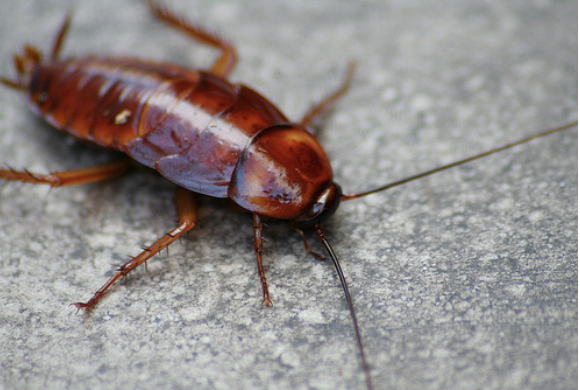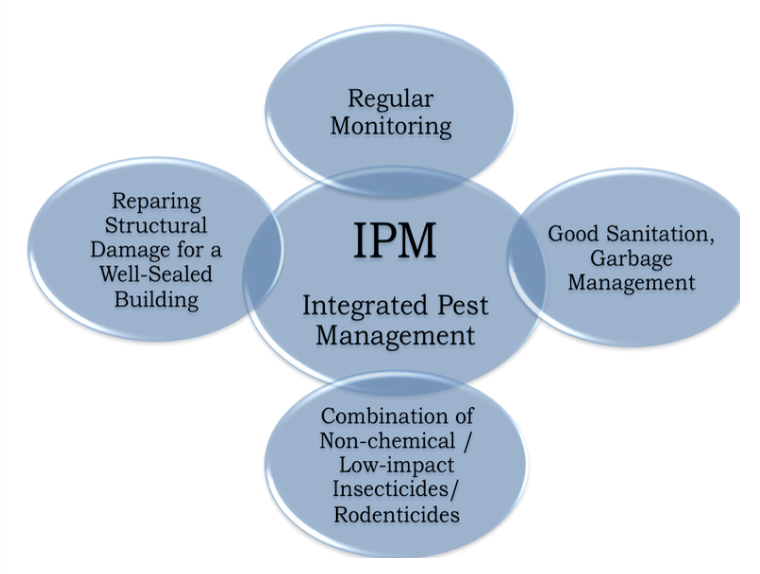Integrated Pest Management (IPM)
New ResidentialWhat is Integrated Pest Management?
Integrated Pest Management (IPM) is a practical and environmentally sensitive approach to pest management that applies to both interiors and exteriors of buildings. It is a decision-making process with a goal of solving pest problems with the least toxic method. IPM programs use comprehensive information on the life cycles of pests and their interaction with the environment. This information, in combination with available pest control methods, is used to manage pest damage by the most economical means, and with the least possible hazard to people, property, and the environment.[1]
Pesticides can contribute to indoor air quality problems, and other hazards include acute, immediate toxicity to humans and other non-target organisms; chronic or long-term toxicity such as cancer; and potential to contaminate air, or ground and surface water. Some pests develop a resistance to specific pesticides, and in turn, require stronger chemicals for pest control. Pesticide labels, Material Safety Data Sheets (MSDS) and resources such as Pesticide Action Network Pesticide Database provide information on many of these potential hazards for specific pesticides.[2] MSDS are documents prepared by a product’s manufacturer to provide information on the safe use and potential hazards of a product.
In structural pest control (pest control in and around buildings), IPM focuses mainly on eliminating or reducing sources of food, water, and hiding spots that are available to pests, and limiting pest access into and throughout buildings. Control measures such as sanitation and building maintenance are essential aspects of a structural IPM program. Success requires the collaborative efforts of everyone involved in the management and maintenance of a building including service contractors, tenants, occupants, and cleaning staff. Education and cooperation are necessary parts of any IPM program.[3]

Figure 1 – A typical household cockroach (Source: http://www.flickr.com/photos/johnas/3481624912/)
How to Implement Integrated Pest Management
Each IPM program is designed around individual pest prevention goals and eradication needs, considered in the context of the environment or setting. Although tailored for each setting, most successful IPM programs use the same four-tiered approach that includes 1) Setting action thresholds or defining the level for controlling a pest. 2) Monitoring and identifying pests. This step helps identify if and what pest problems exist and helps reduce the unnecessary use of pesticides. 3) Prevention, which includes proactive methods to prevent pests from becoming a threat such as repairing structural damage in a building and good garbage management. 4) Control. If necessary, implement strategic control methods such as mechanical control (trapping), or highly targeted chemicals. [4]
IPM recommendations developed Rutgers University identifies regular monitoring, repairing structural damage, proper sanitation and a combination of non-chemical/low-impact pesticides as critical components of a typical structural IPM program (see Figure 2).
Hiring a vendor who uses IPM practices help ensure the safe and effective management of pests in and around the building. It is likely that vendors recommend cleaning up areas and making repairs. Simple changes may include cleaning up break rooms and not overwatering plants. More complex and expensive changes may involve patching holes and crevices, repairing leaks, sealing floor drains and vents, sealing cracks and other access areas for pests, and installing door sweeps.

(Source: Rutgers Center for Green Building and Rutgers NJ Agricultural Experiment Station Cooperative Extension. A Guide to Integrated Pest Management. 2012.)
Benefits
Integrated Pest Management:
- Promotes sound structures and healthy plants
- Improves pest control
- Promotes sustainable bio-based pest management alternatives
- Reduces the environmental risk associated with pest management by encouraging the adoption of more ecologically benign control tactics
- Reduces or eliminates issues related to pesticide residue
- Decreases occupant exposure to pesticides
- Reduces concern about pests & pesticide-related practices
- Maintains or increases the cost-effectiveness of pest management programs[5]
- Prevents the contamination of indoor air, buildings, soil, and water and keeps hazardous chemicals out of the food chain
- Protects people (especially children and other vulnerable populations), animals and beneficial plants and insects from toxic exposures
Costs
IPM can reduce long-term pest management costs. Often IPM programs cost the same or less than traditional pest management programs. Costs may rise during the transition period as new equipment is acquired or after building upgrades. IPM can reduce costs by eliminating regular pesticide spraying, but those savings may be redirected toward preventive practices, such as training employees, inspecting for pests, and investing in building and landscaping improvements. Over time these budget shifts balance out, and improved maintenance, better sanitation and making repairs help make the building more attractive to everyone except pests.[6]
Resiliency
Minimizing the use of hazardous pesticides reduces the risk of spills and contamination during an emergency event. Less risk of pesticide exposure or dangerous chemical combinations makes clean up and recovery less dangerous and more efficient. Managing pests through an effective and environmentally sensitive program helps create a healthier indoor environment that can help protect occupant health.
[1] US EPA. Integrated Pest Management (IPM) Principles. https://www.epa.gov/safepestcontrol/integrated-pest-management-ipm-principles (accessed December 28, 2018).
[2] The IPM Institute of North America. http://www.ipminstitute.org/faq.htm#Whatarepesticiderisks? (accessed December 28, 2018).
[3] Mass.gov. IPM Kit for Building Managers. https://www.mass.gov/files/documents/2016/08/wk/ipm-kit-for-bldg-mgrs.pdf (accessed December 28, 2018).
[4] US EPA. Integrated Pest Management (IPM) Principles. https://www.epa.gov/safepestcontrol/integrated-pest-management-ipm-principles (accessed December 28, 2018).
[5] Mass.gov. IPM Kit for Building Managers. https://www.mass.gov/files/documents/2016/08/wk/ipm-kit-for-bldg-mgrs.pdf (accessed March 26, 2019).
[6] Mass.gov. IPM Kit for Building Managers. https://www.mass.gov/files/documents/2016/08/wk/ipm-kit-for-bldg-mgrs.pdf (accessed March 26, 2019).
Related Strategies
Resources
- Integrated Pest Management Kit for Building Managers
- IPM Institute of North America
- National Pesticide Information Center – Household IPM
- Northeastern IPM Center
- Rutgers Cooperative Extension Pest Management – IPM Programs
- Sustainable Jersey – Integrated Pest Management
- US EPA Integrated Pest Management Principles
- US EPA Pesticide Environmental Stewardship Program (PESP)
